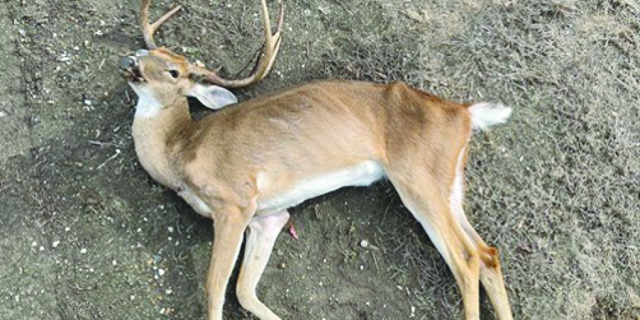LWFC emergency declaration enlarges CWD Control Area after latest case
Published 2:00 pm Tuesday, April 8, 2025

- CWD-infected deer are emaciated, such as this deer found in Louisiana. THE DAILY IBERIAN FILES
A Declaration of Emergency and Notice of Intent to address the growing problem of Chronic Wasting Disease in the state’s deer herd was approved Thursday, April 3, by the Louisiana Wildlife and Fisheries Commission.
The DE, which prohibits baiting and supplemental feeding of deer in an expanded CWD Control Area, goes into effect May 1. It enlarges the previously established CWD Control Area to include an area inside a 25-mile radius where a wild deer recently tested positive for CWD in Catahoula Parish. The new control area includes portions of Caldwell, Richland, La Salle and Catahoula parishes.
All of Tensas Parish and portions of East Carroll, Madison, Franklin and Concordia parishes were included in the original control area.
Trending
The DE prohibits the transport of deer carcasses outside of the control area except for specific parts listed, or by permit for purposes of taxidermy.
No question the Louisiana Department of Wildlife and Fisheries’ game biologists and LWFC moved fast on this latest issue and that’s a positive thing considering one of the state’s prized natural resources is threatened even more. The action was taken because of the CWD confirmed positive test on a wild deer killed on private land in March in Catahoula Parish.
A deer hunter harvested the white-tailed buck that proved positive for CWD, the first confirmed case in a wild deer outside of Tensas Parish. The Sportsman’s Paradise’s first CWD case was in 2022 and the latest positive test upped the total number of CWD detections in Louisiana to 40.
The LWFC’s NOI also expanded the CWD Control Area but established a smaller mitigation area within the CWD Control Area for baiting and supplemental feeding. A prepared statement released April 3 by the LDWF noted while the carcass exportation and enhanced surveillance components of the proposed rule extend to the entire control area, the NOI “proposes a smaller area of approximately 15-mile radius from any CWD positive case where supplemental feeding or baiting is prohibited.”
Supplemental feeding and baiting outside the 15-mile boundary outward to the control area boundary would be allowed through mechanical broadcast from nonstationary implements, according to LDWF.
The NOI will be published for public comment and could be amended before final adoption. Deer hunters are reminded the NOI is a proposed rule and won’t go into effect until final passage by the LWFC, which at the earliest could be August 2025.
Trending
A couple points to note:
The DE is a temporary action that will become effective May 1 and stay in effect for a period of 180 days or until the NOI becomes final and replaces the DE.
LDWF officials emphasized there is no statewide feeding ban included in either the DE or the NOI.
According to game biologists and numerous studies, CWD is a neurodegenerative disease of white-tailed deer and other members of the family Cervidae. It is caused by an infectious, misfolded protein particle called a prion and is 100 percent fatal.
Animals can pass the disease to others indirectly and directly because the prions can be found in the animal’s tissue and bodily fluids, such as in blood and muscles. Once prions are in the environment, they can last for years, absorbed into the soil and absorbed by plants.
Feeding deer often is discouraged because large numbers of animals frequenting one spot can infect others.
LDWF also pointed out there is no treatment or preventative vaccine for CWD, which causes weight loss and emaciation, salivation, frequent drinking and urination, uncoordinated movements, circling, lack of fear of people and an inevitable death.
DON SHOOPMAN is outdoors editor of The Daily Iberian.





